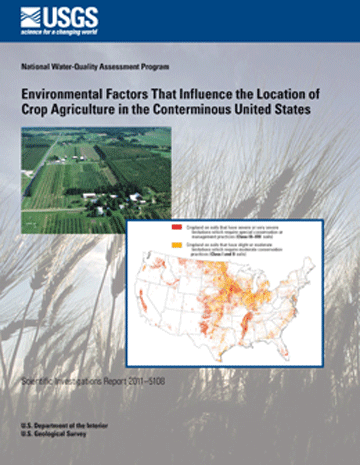Scientific Investigations Report 2011–5108
By Nancy T. Baker and Paul D. Capel

AbstractThis report presents and describes high-resolution geospatial data identifying the range of environmental conditions that influence the location of cropped agricultural lands in the conterminous United States. Also presented are estimates of the extent of land where environmental constraints limit agricultural production (marginal land) and the extents of land where modifications overcome environmental constraints. The report is the result of the compilation and manipulation of datasets from numerous sources; it consists of an explanatory text and a series of appendixes and associated tables that document the data sources and data-manipulation methods in detail.
Most crops are grown on land with shallow slope where the temperature, precipitation, and soils are favorable. In areas that are too steep, wet, or dry, landscapes have been modified to allow cultivation. Some of the limitations of the environmental factors that determine the location of agriculture can be overcome through modifications, but others cannot. On a larger-than-field scale, agricultural modifications commonly influence water availability through irrigation and (or) drainage and soil fertility and (or) organic-matter content through amendments such as manure, commercial fertilizer and lime. In general, it is not feasible to modify the other environmental factors, soil texture, soil depth, soil mineralogy, temperature, and terrain at large scales. |
First posted August 2, 2011
For additional information contact: Part or all of this report is presented in Portable Document Format (PDF); the latest version of Adobe Reader or similar software is required to view it. Download the latest version of Adobe Reader, free of charge. |
Baker, N.T., and Capel, P.D., 2011, Environmental factors that influence the location of crop agriculture in the conterminous United States: U.S. Geological Survey Scientific Investigations Report 2011–5108, 72 p.
Abstract
Introduction: Why Is Crop Agriculture Located Where It Is?
Environmental Factors That Influence the Location of Crop Agriculture
Other Land Uses in Competition for Agricultural Lands
Summary
References Cited
Appendix 1—Development of Croplands in the United States
Appendix 2—Environmental Factors That Influence the Location of Crop Agriculture
Appendix 3—Elevation and Slope
Appendix 4—Climate
Appendix 5—Soil
Appendix 6—Soil Water
Appendix 7—Other Land Uses in Competition for Agricultural Lands
Appendix 8—Summary of Data Sources and Online Links to Datasets
References Cited in the Appendixes